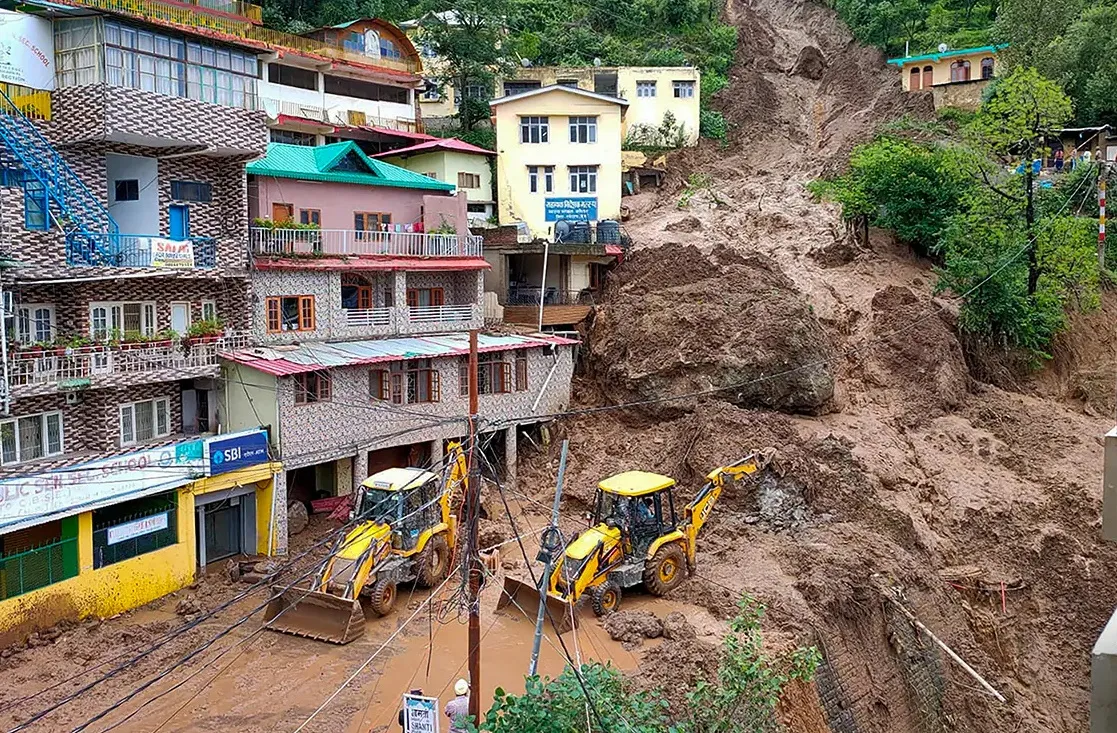India is witnessing monsoon fury like never before — killer landslides, flash floods and cloudbursts tearing through towns, sweeping away homes, and claiming hundreds of lives while destroying property worth crores. The climate crisis is no longer a distant projection. It is unfolding in real time, and its impact is being felt across India more violently than ever before.
This year’s monsoon has hit India hard—since April, nearly 1,300 people have lost their lives to floods, landslides, and lightning. Andhra Pradesh, Himachal Pradesh, Madhya Pradesh, and Bihar were among the worst affected states. Beyond the tragic loss of life, almost 93,000 homes were damaged and over 154,000 hectares of crops destroyed. Assam saw the most crop damage. The impact reached livestock too—over 51,000 cattle died nationwide.
The government has stepped in with ₹9,578 crore for disaster relief across 22 states and sent a team to Himachal Pradesh to assess the hardest-hit areas.
While managing disasters is mainly up to each state, central support is helping with relief and rebuilding efforts.
For centuries, the monsoon has been India’s lifeline — nurturing crops, replenishing rivers and sustaining livelihoods. But scientists now warn that it is being reshaped by climate change. As global temperatures rise, the atmosphere retains more moisture. Both the Indian Ocean and the Arabian Sea are now feeding more water vapor into the monsoon system, supercharging it and making rain events heavier, shorter, and far less predictable.
In the past, monsoon rains were steady and evenly spread across four months — June to September. Today, meteorologists observe an alarming pattern: prolonged dry spells abruptly ending in cloudbursts and torrential downpours concentrated over small areas. The consequences are devastating — particularly in mountainous terrain where massive moisture-laden clouds slam into the hillsides, releasing torrents of rain in minutes.

This was precisely what happened in the Himalayan states of Uttarakhand, Himachal Pradesh and Kashmir during early August this year. The India Meteorological Department (IMD) attributed the devastation to an unusual interaction between the southwest monsoon and westerly disturbances — cold-air systems originating in the Mediterranean that drift eastward. The collision of these systems created what scientists call a “rare atmospheric tango,” producing incessant, extreme rainfall.
Meteorologist Akshay Deoras of the University of Reading described it vividly: “Think of the monsoon as a loaded water cannon, and westerly disturbances as the trigger.” The result was catastrophic — rivers swelling into fury, hills collapsing, and towns drowning under unprecedented rainfall.
The damage this year has been staggering. In Uttarakhand alone, over 1,500 landslides have been recorded so far — the highest in decades. In Mizoram, more than 900 landslides since May have damaged or destroyed over 280 buildings, displaced hundreds of families, and fractured vital road links. Punjab and Haryana endured days of relentless rain in August, flooding more than 1,400 villages and affecting over 3.5 million people, causing damage running into thousands of crores.

This pattern mirrors a grim timeline of intensifying monsoon disasters. In Kerala’s Wayanad last year, cloudbursts triggered landslides that killed over 200 people, with studies later confirming that climate change had amplified the rainfall by nearly 10 %. Earlier, in Karnataka (2019), floods claimed 61 lives and caused damage exceeding ₹35,000 crore. Even Maharashtra’s 2021 floods, which killed over 200, caused losses of around ₹4,000 crore. The trajectory is unmistakable — every few years, the toll climbs higher.
Scientific evidence confirms this escalation. A comprehensive IMD analysis and independent studies show that extreme precipitation events during the Indian summer monsoon have steadily increased between 1901 and 2020. Warmer seas are fueling moisture build-up, while changing jet stream patterns — fast-flowing air currents in the upper atmosphere — have become more “wavy” and erratic. This waviness is dragging western disturbances farther south, fueling storm systems and prolonging heavy rainfall over regions unaccustomed to such deluges.
A study by the Council on Energy, Environment and Water (CEEW) found that over the last five decades, the frequency of flood events in India has increased eightfold. Since 2005, the number of districts affected by extreme floods has tripled — from 19 per year to 55. In short, India’s monsoon is no longer the same — it is faster, fiercer, and far less forgiving.
These recurring calamities extract a colossal human and economic cost. Roads, bridges, crops, homes, and public infrastructure worth crores are lost each year. Relief, rehabilitation and reconstruction drain public resources that could otherwise be invested in resilience.
But beyond statistics lies a simple truth: the monsoon, once India’s blessing, is turning into a force of destruction. The nation must move from reaction to preparation — strengthening early warning systems, enforcing land-use regulation in fragile regions, restoring natural buffers such as forests and wetlands, and integrating climate risk into every development plan.
The climate crisis has turned India’s monsoon from a predictable rhythm into a volatile threat. The question is no longer if disaster will strike, but when — and how many will be caught unprepared.





